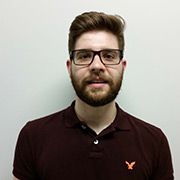From theory to practice
By Betty Zou
When Bogdan Stankovic was a child, he would go with his dad to pick up his mom after her shifts as a nurse in the intensive care unit at Sunnybrook. As she recounted her day, he would hear about the cases she saw and the doctors she worked with at Canada’s largest regional trauma centre. Many years later, when he was searching for a lab in which he could gain research experience, trauma and Sunnybrook seemed a natural fit.
Stankovic got his first taste of research last summer when he completed a short stint as a volunteer in the lab of Dr. Marc Jeschke at Sunnybrook Research Institute (SRI). “I just took a chance, and it turns out I actually like [research] a lot,” he says. “It was one of those cases where I could apply the theory that I learned hands-on. I found it kind of cool.” He liked it so much that he decided to apply for a full-time summer research position this year.
A fourth-year undergraduate student at the University of Toronto majoring in cell systems biology and human biology, Stankovic is completing a research project in the Jeschke lab as part of the D+H SRI Summer Student Research Program. Jeschke is a senior scientist in SRI’s Trauma, Emergency & Critical Care Research Program and the director of the Ross Tilley Burn Centre at Sunnybrook. His research is focused on understanding and improving the body’s stress response to severe trauma such as burns.
As a result of the stress inflicted on the body, trauma patients often develop insulin resistance and hyperglycemia, where there is an excess of glucose sugar in the bloodstream. Stankovic is working with Mile Stanojcic, a PhD student in the lab, to understand how trauma causes the body’s glucose metabolism and insulin response pathways to go haywire. They are using a two-hit mouse model of burn and infection to mimic clinical situations where patients with severe burns acquire serious and sometimes life-threatening bacterial infections.
The preliminary results confirmed the validity of the model: mice in the untreated control group were able to clear glucose from their blood, whereas mice in the two-hit treatment group were not. They are now looking at differences in gene and protein expression between the two groups of mice to dissect the molecular mechanism by which glucose intolerance and insulin resistance occur.
“This summer [has] actually been a lot more exciting than last summer,” says Stankovic. “When I look back at how I was last year with how I am this year, I see a big improvement.” He credits his graduate student mentor with helping him improve his time management skills and learn to deal with the unforeseen challenges that arise during an experiment. “He really showed me how many steps and how much planning ahead it actually takes to design a study,” he says.
In the fall, Stankovic will be heading back to U of T for a fifth year. After two great experiences in a research lab, he is considering expanding his research endeavours.
“It’s definitely pushed me toward thinking about some sort of graduate degree,” says Stankovic.
Sounds like he’s been bitten by the research bug.
Bogdan Stankovic received a D+H Summer Studentship Award.



